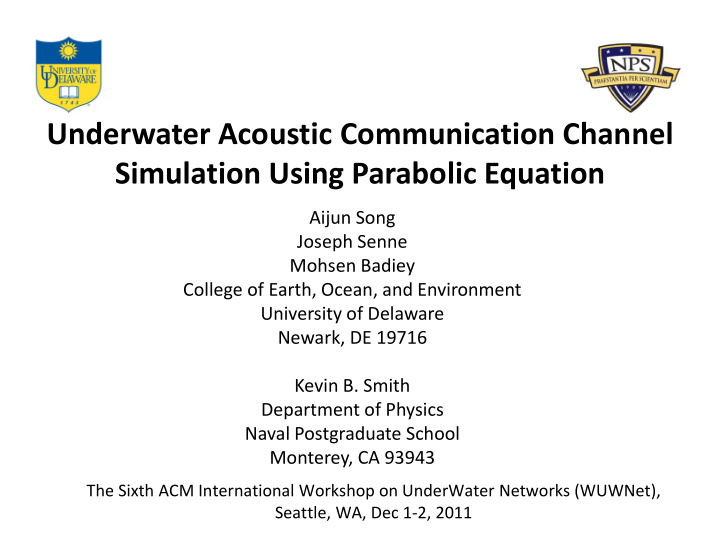



Underwater Acoustic Communication Channel Simulation Using Parabolic Equation Aijun Song Joseph Senne Mohsen Badiey College of Earth, Ocean, and Environment University of Delaware Newark, DE 19716 Kevin B. Smith Department of Physics Naval Postgraduate School Monterey, CA 93943 The Sixth ACM International Workshop on UnderWater Networks (WUWNet), Seattle, WA, Dec 1 ‐ 2, 2011
Outline • Motivation • Channel simulator using parabolic equation • Case study from KAM08 • Summary
Motivation • Increasing need for high frequency acoustic communication (10 ‐ 50 kHz) • At ‐ sea experiments for receiver design and algorithm validation • Channel models are needed – Receiver design and evaluation – Capacity, channel limits – Network ‐ level research
Channel simulation • Data ‐ driven channel simulators (Walree, Jenserud, and Smedsrud, JSAC 2008, etc.) • Ray ‐ based channel simulators (Siderius and Porter, JASA 2008, etc.) • Our approach: parabolic equation for modeling of time ‐ varying acoustic channels – Use environmental measurements as input – Output compared with measured impulse responses – Communication performance compared
Complex physical processes • Affecting high frequency sound propagation in coastal regions (Stochastic and deterministic): 10 ‐ 50 kHz
Surface effects • Acoustic frequencies: 10 ‐ 50 kHz • Reflection/scattering, time ‐ varying returns
Surface effects: Short ‐ term fluctuations Kam08 data: Water depth: 102 m Carrier freq=15 kHz Transducer @ 82.5 m Hydrophone @ 100 m Comm. range: 1 km 1: Direct path 2: Bottom path 3: Surface path 4: Surface-bottom path
Channel simulator • Construct the ocean environment – Static ocean parameters – Time ‐ evolving surface wave
Linear surface wave model • Surface wave spectra as input • Two dimensional initial water surface – Uniformly distributed random phases assumed • Surface made evolving using Runge ‐ Kutta integrator (Dommermuth and Yue, JMF 1987) • Output surface displacement, first and second derivatives of surface height with respect to range
Channel simulator (contd.) • Monterey ‐ Miami parabolic equation (MMPE) model – Reflection/scattering effects from the surface – Propagation through water column
MMPE model • Numerical solution of forward acoustic wave equation – Employs a split ‐ step Fourier marching algorithm for range ‐ dependent environment • Addressing surface effects – Pressure release boundary shifts to water surface – Small angle approximation • Broadband calculation at multiple frequency bins from MMPE then give time ‐ varying impulse responses
Channel simulator (contd.) • Time ‐ evolving ocean environment • Time ‐ varying acoustic field and impulse responses
Case study (KAM08) • Water depth: ~100 m • Maximum ‐ length sequence (cf=15 kHz, 30 sec) • SD=82.5 m and 5 ‐ element receiver (2.4 m aperture)
Surface wave measurement Relatively calm surface (significant wave height=0.7 m)
Evolving surface wave
Channel simulation • Water depth=100 m, Range= 1 km • Ocean environment (surface wave) evolving every quarter of a second • Each time ocean environment changes, a broadband MMPE calculation is performed – 512 frequency points over the frequency band – Grid size: wavelength in range and one ‐ ten of wavelength in depth – 30 seconds of the communication channel
Data ‐ model comparison • SD=82.5 m, RD=100 m, and Range=1 km 1: Direct path 2: Bottom path 3: Surface path 4: Surface-bottom path Experimental Data
Data ‐ model comparison • SD=82.5 m, RD=100 m, and Range=1 km Model output Experimental Data
Averaged intensity profile matching intensity profiles
Coherence of the surface paths similar surface correlation properties
Further comparison: Scattering function • SD=82.5 m, RD=100 m, and Range=1 km Model output Experimental Data
More surface bounces
Other array elements CH ‐ 5 (RD=97.6 m) CH ‐ 3 (RD=98.8 m)
Realistic simulation of communication performance
Time reversal Receiver Output SNR (Inverse of mse) Time reversal enhanced by single channel DFE, with channel updates A. Song, M. Badiey, H. ‐ C. Song, W. S. Hodgkiss, and M. B. Porter, JASA 2008
• The average raw SNR was 31 dB at the receiving array from KAM08 • The simulation used the same raw SNR and measured ambient noise from KAM08 – Denser sampling rate for surface waves (32 Hz) • Impulse responses – 60 ms (signal generation) versus 25 ms (estimation) • Channel update interval: 80 ms
Impulse responses • Communication for 5 seconds Data Model output
Receiver performance • Equalizer soft output for 5 seconds Data Model output
Channel update interval
Summary • An integrated model using a time ‐ evolving linear surface and a MMPE model • Realistic acoustic communication channels simulated • Comparable communication performance between data and model output
Recommend
More recommend